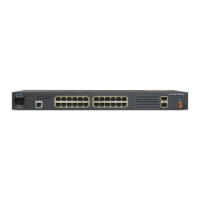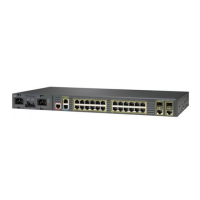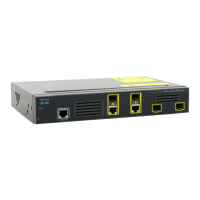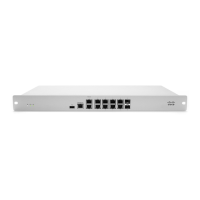33-66
Cisco ME 3400 Ethernet Access Switch Software Configuration Guide
OL-9639-07
Chapter 33 Configuring QoS
Configuration Examples for Policy Maps
classification statistics, but you can determine these statistics by configuring policing at line rate for the
class. In this case, no packets exceed the configured policer profile, and the policer conform statistics
would equal the class classification statistics.
Another way to view input QoS statistics is in the output of the show platform qos statistics interface
[interface-id] privileged EXEC command. The per-port frame statistics are sorted by the DSCP and CoS
values of the incoming frames on the port. These statistics do not provide any information about the
MQC input policy map configured on the interface.
For output policy maps, you can use the show policy-map interface [interface-id] command to display
per-class classification statistics that show the total number of packets that match the specified class.
This count includes the total number of packets that are sent and dropped for that class. You can use the
same command to view the per-class tail drop statistics.
Configuration Examples for Policy Maps
This section includes configuration examples for configuring QoS policies on the Cisco ME switch,
including configuration limitations and restrictions. The sections are broken into different configurations
actions that a customer might do. Each section provides the exact sequence of steps that you must follow
for successful configuration or modification.
• QoS Configuration for Customer A, page 33-66
• QoS Configuration for Customer B, page 33-68
• Modifying Output Policies and Adding or Deleting Classification Criteria, page 33-69
• Modifying Output Policies and Changing Queuing or Scheduling Parameters, page 33-70
• Modifying Output Policies and Adding or Deleting Configured Actions, page 33-70
• Modifying Output Policies and Adding or Deleting a Class, page 33-71
QoS Configuration for Customer A
This section provides examples of the initial configuration and activation of QoS policies for a customer
switch. Input and output QoS service policies are configured based on the requirements and attached to
relevant ports.
In the initial configuration for Customer A, Fast Ethernet ports 1 through 24 are user network interfaces
(UNIs) and are disabled by default. Gigabit Ethernet ports 1 and 2 are network node interfaces (NNIs)
and are enabled by default.
This is the overall sequence for initial configuration:
• Configure classes and policies.
• Shut down all active ports.
• Attach policies to ports to be activated.
• Take the ports out of the shut-down state.
• Leave unused ports shut down.
Note these restrictions for configuring output policies:
• You can define up to three classes in the output policy map.
• The defined classes must be the same as other output policy maps.

